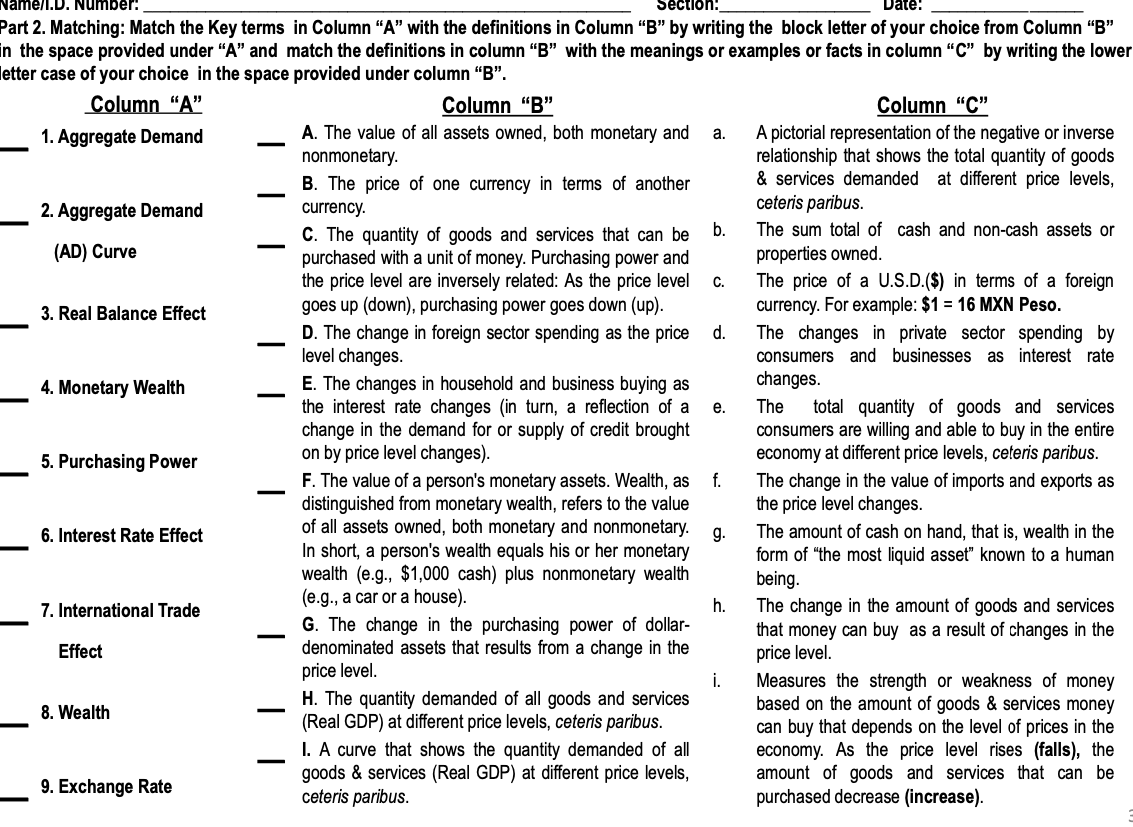I want only answers to questions #1, 3, 5, 7, 9 Colums "C" . I got answers to Colums "A" already. My answers are 1H, 3G, 5C, 7D 9B, missing Colums C. Thank you.
Mamerw. NHI'I'IIJGE column II a I! 1. Aggregate Demand 2. Aggregate Demand (AD) Curve 3. Real Balance Effect 4. Monetary Wealth 5. Purchasing Power 6. Interest Rate Effect 7. International Trade Effect 8. Wealth 9. Exchange Rate aecnon: Part 2. Illatching: Match the Key terms In Column \"A" with the denitions in Column \"B" by writing the block letter of your choice from Column \"B\" In the space provided under \"A\" and match the denitions in column \"B" with the meanings or examples or facts in column \"C" by writing the lower letter case of your choice In the space provided under column \"B". Column \"B\" A. The value of all assets owned, both monetary and nonmonetary. B. The price of one currency in temts of another currency. C. The quantity of goods and services that can be purchased with a unit of money. Purchasing power and the price level are inversely related: As the price level goes up (down), purchasing power goes down (up). D. The change in foreign sector spending as the price level changes. E. The changes in household and business buying as the interest rate changes (in turn, a reection of a change in the demand for or supply of credit brought on by price level changes). F. The value of a person's monetary assets. Wealth, as distinguished from monetary wealth, refers to the value of all assets owned, both monetary and nonmonetary. In short, a person's wealth equals his or her monetary wealth (e.g., $1,000 cash) plus nonmonetary wealth (e.g., a car or a house). 6. The change in the purchasing power of dollar- denominated assets that results from a change in the price level. H. The quantity demanded of all goods and services (Real GDP) at different price levels, ceteris panbus. I. A curve that shows the quantity demanded of all goods a services (Real GDP) at different price levels, ceteris parrbus. a. uale: Column \"C\" A pictorial representation of the negative or inverse relationship that shows the total quantity of goods a services demanded at different price levels, ceteris parr'bus. The sum total of cash and non-cash assets or properties owned. The price of a U.S.D.($) in terms of a foreign currency. For example: $1 =16 IrinI Peso. The changes in private sector spending by consumers and businesses as interest rate changes. The total quantity of goods and services consumers are willing and able to buy in the entire economy at different price levels, cafen's paribus. The change in the value of imports and exports as the price level changes. The amount of cash on hand, that is, wealth in the form of "the most liquid asset\" known to a human being. The change in the amount of goods and services that money can buy as a result of changes in the price level. Measures the strength or weakness of money based on the amount of goods & services money can buy that depends on the level of prices in the economy. As the price level rises (falls), the amount of goods and services that can be purchased decrease (increase)







